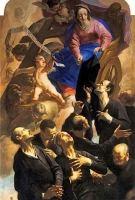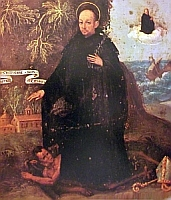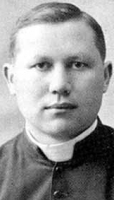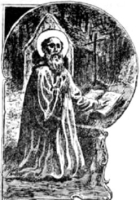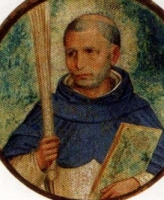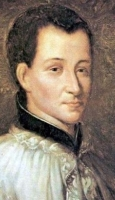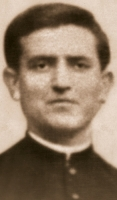Servites
மரியாளின் ஊழியர்கள் சபையின் ஏழு நிறுவனர்கள்
அர்ப்பண வாழ்க்கை நிறுவனம் (Mendicant Order (Institute of Consecrated Life)
மரியான் பக்தி சமுதாயம் (Marian Devotional Society)
உருவாக்கம்: ஆகஸ்ட் 15, 1233
உலகின் வசதி வாய்ப்புள்ள ஏதேனும் ஒரு நகரிலுள்ள ஏழு முக்கிய பிரமுகர்கள் ஒன்றுசேர்ந்து, தங்கள் வீடுகளையும், உத்தியோகங்களையும் விட்டுவிட்டு, நேரடியாக கடவுளுக்கு சேவை செய்வதற்காக அர்ப்பணிக்கப்பட்ட ஒரு வாழ்க்கைக்காக தனிமையில் வாழப் போகிறார்கள் என்று நினைக்க இயலுகிறதா? ஆனால், கி.பி. 13ம் நூற்றாண்டின் மத்தியில், இத்தாலி நாட்டின் மேற்கு-மத்திய பிராந்தியமான “டுஸ்கனியின்” (Tuscany) வளர்ந்த, வளமான, பணக்கார தலைநகரான “ஃபுளோரன்ஸ்” (Florence) நகரில் இதுதான் நடந்தது. அரசியல் சச்சரவுகளாலும், "கத்தாரியின்" (Catharism) மதங்களுக்கு எதிரான கொள்கைகளாலும் சின்னாபின்னமாகியிருந்த அக்காலத்தில் அறநெறிகள் குறைவாகவும், சமயங்களும் ஆன்மீக உணர்வுகளும் அர்த்தமற்றதாகவும் தோன்றியது.
கி.பி. 1240ம் ஆண்டு, ஃபுளோரன்ஸ் நகரின் பிரபுக்கள் குடும்பங்களைச் சேர்ந்த எழுவர், பிரார்த்தனைகள் மூலம் கடவுளுக்கு நேரடி சேவை செய்யும் நோக்கில், நகரையும் தமது குடும்பங்களையும் விட்டு விலகி, தனிமை வாழ்வு வாழ பரஸ்பரம் முடிவு செய்தனர். அவர்களது ஆரம்ப பிரச்சினையே, தம்மைச் சார்ந்திருப்பவர்களுக்கு செய்ய வேண்டிய கடமைகளே. காரணம், அவர்களில் இருவர் ஏற்கனவே திருமணமானவர்கள். இருவர் திருமணமாகி, மனைவியை இழந்தவர்கள். அவர்களின் நோக்கமே, தவம் மற்றும் பிரார்த்தனைகளுடனான ஒரு வாழ்க்கை வாழ்வதேயாம். ஆனால், விரைவிலேயே அவர்கள் ஃபுளோரன்ஸ் நகரிலிருந்து தம்மை அடிக்கடி காண வந்த பார்வையாளர்களால் தொந்தரவை உணர்ந்தனர். பின்னர் அவர்கள், “வக்லியா” (Vaglia) எனுமிடத்திலுள்ள “மான்டே செனரியோ” (Monte Senario) துறவு மடத்தின் வனாந்தரமான சரிவுகளுக்கு திரும்பினர்.
கி.பி. 1244ம் ஆண்டு, தூய பீட்டரின் (Saint Peter of Verona) வழிகாட்டுதலின்படி, இச்சிறிய குழு, டொமினிக்கன் சபையினரின் துறவற சீருடையைப் போன்ற சீருடையை ஏற்றுக்கொண்டனர். தூய அகுஸ்தினாரின் (St. Augustine) சட்ட விதிகளின்படி வாழ முடிவு செய்தனர். “மரியாளின் ஊழியர்கள்” (Servants of Mary) எனும் பெயரை ஏற்றுக்கொண்டார். அதன் குறிக்கோள்கள், அதன் உறுப்பினர்களின் புனிதத்துவமும், நற்செய்தியைப் பிரசங்கிப்பதும், கடவுளின் அதிதூய தாயாரான கன்னி மரியாளின் வியாகுலங்களுக்கு முக்கியத்துவம் தந்து, அவரது பக்தியை பரப்புவதுமாகும்.
ஆரம்பத்திலிருந்தே இச்சபையின் உறுப்பினர்கள், வியாகுல அன்னை மரியாளுக்கு தம்மை அர்ப்பணித்திருந்தனர். இயேசுவின் அன்னைக்கு தமது பக்தியை அர்ப்பணித்த இவர்கள், அன்னை மரியாளின் விருந்தோம்பல் மற்றும் இரக்கத்தினை தமது முத்திரையாக ஏற்றுக்கொண்டனர்.
“மரியாளின் ஊழியர்கள் சபையின்" (Servite Order) ஏழு நிறுவனர்கள் (Seven Holy Founders):
1. புனிதர் போன்ஃபிளியஸ் (St. Buonfiglio dei Monaldi (Bonfilius)
2. புனிதர் பொனஜுன்க்டா (St. Giovanni di Buonagiunta (Bonajuncta)
3. புனிதர் பார்டொலொமியஸ் (St. Amadeus of the Amidei (Bartolomeus)
4. புனிதர் ஹூக் (St. Ricovero dei Lippi-Ugguccioni (Hugh)
5. புனிதர் மனேட்டஸ் (Benedetto dell' Antella (Manettus)
6. புனிதர் சோஸ்டென் (Gherardino di Sostegno (Sostene)
7. புனிதர் அலெக்ஸியஸ் (St. Alessio de' Falconieri (Alexius)
கி.பி. 1888ம் ஆண்டு, ஜனவரி மாதம், பதினைந்தாம் நாளன்று, திருத்தந்தை “பதின்மூன்றாம் லியோ” (Pope Leo XIII), இவர்களனைவரையும் புனிதர்களாக அருட்பொழிவு செய்வித்தார்.
Also known as
• Confraternity of Our Lady
• Order of Servants of Mary
• Servant Friars
• The Seven Holy Founders
About
Named the fifth mendicant order by Pope Martin V, it was founded in 1233 by
• Saint Alexis Falconieri
• Saint Bartholomew degli Amidei
• Saint Benedict dell'Antella
• Saint Buonfiglio Monaldi
• Saint Gherardino Sostegni
• Saint Hugh dei Lippi-Uguccioni
• Saint John Buonagiunta Monetti
On the Feast of the Assumption of the Blessed Virgin Mary in 1240 the Founders received a vision of Our Lady. She held in her hand the black habit, and a nearby angel bore a scroll reading Servants of Mary. Mary told them,
"You will found a new order, and you will be my witnesses throughout the world. This is your name: Servants of Mary. This is your rule: that of Saint Augustine. And here is your distinctive sign: the black scapular, in memory of my sufferings."
From their first establishment at La Camarzia, near Florence, Italy, they removed to the more secluded Monte Senario where the Blessed Virgin herself conferred on them their habit, instructing them to follow the Rule of Saint Augustine and to admit associates. Official approval was obtained in 1249; confirmed in 1256; suppressed in 1276; definitely approved in 1304; and again by Brief in 1928. The order was so rapidly diffused that by 1285 there were 10,000 members with houses in Germany, France, Italy, and Spain, and early in the 14th century it numbered 100 convents, besides missions in Crete and India. The Reformation reduced the order in Germany, but it flourished elsewhere. Again meeting with political reverses in the late 18th and early 19th centuries, it nevertheless prospered, being established in England in 1867, and in America in 1870. The Servites take solemn vows and venerate in a special manner the Seven Dolors of Our Lady. They cultivate both the interior and the active life, giving missions and teaching.
An affiliation, professing exclusively the contemplative life is that of the Hermits of Monte Senario. Reinstated in France, 1922. Cloistered nuns, forming a Second Order, have been affiliated with the Servites since 1619 when Blessed Benedicta di Rossi called the nuns of her community Servite Hermitesses. They have been established in England, Spain, Italy, the Tyrol, and Germany.
A Third Order, the Mantellate, founded by Saint Juliana Falconieri under Saint Philip Benizi, c.1284, has houses in Italy, France, Spain, England, Canada, and the United States. Secular tertiaries and a confraternity of the Seven Dolors are other branches.
Canonized
1887 by Pope Leo XIII
Blessed Edvige Carboni
Profile
The second child of Giovanni Battista Carboni and Maria Domenica Pinna, Edvige had to leave school at the 4th grade. She felt drawn to the religious life, but stayed at her parents' home to care for her chronically ill mother; she spent all her free time there in prayer. On 14 July 1911 she received the signs of the stigmata; she tried to hide it and the blood stains that resulted, but it soon became obvious. She moved to Rome, Italy just prior to the outbreak of World War II; she spent the war years working with charities and praying for all the dead. She reported apparitions of Jesus Christ, Saint Anne, Saint Catherine of Siena, Saint Dominic Savio, Saint Francis of Assisi, Saint Gemma Galgani, Saint Genaro of Naples, Saint John Bosco, Saint Paul the Apostle, Saint Rita of Cascia, Saint Sebastian, Saint Thérèse of Lisieux, and attacks by demons.
Born
late night of 2 May 1880 in Pozzomaggiore, Sassari, Italy
Died
• 10:30pm on 17 February 1952 in Rome, Italy of angina pectoris
• buried in Albano Laziale, Italy next to her brother
• re-interred at the Pontifical Sanctuary of Santa Maria Goretti in Nettuno, Rome, Italy on 6 October 2015
Beatified
• 15 June 2019 by Pope Francis
• beatification recognition celebrated at the Ippodromo Generale Eugenio Unali, Pozzomaggiore, Sassari, Italy, presided by Cardinal Giovanni Angelo Becciu
Martyrs of Concordia
Also known as
Martyrs of Porto Gruaro
Profile
In the early 4th century, the brothers Donatus and Solone travelled from Vicenza to Iulia Concordia to evangelize, and brought many to the faith. As part of the persecutions of Diocletian, governor Euphemio also came to Iulia Concordia, determined to restore the old pagan religion. He arrested any Christians he could find and ordered them to denounce their new faith. Those who refused where tortured, whipped and eventually executed; between 72 and 85 (records vary) held firm and were beheaded. We know the names of some, but little else about any of them - Cordius, Crisantus, Donatus, Ermogius, Eutichius, Giustus, Lucilla, Neomedius, Policrazius, Romulus, Secondian, Silvanus, and Solone.
Died
• beheaded on 17 February 304 at Porto Gruaro on the banks of the Lemene River outside Iulia Concordia (modern Concodia Saggitaria), Italy
• the bodies were collected and given proper burial by local people
• a chapel was built on the site of the executions; it was later incorporated in the construction of the Cathedral of Saint Stephen the Proto-Martyr
• the bones were later collected and placed in a communal urn which was enshrined in the chapel within the cathedral
• the chapel was declared a diocesan sanctuary by Bishop Giuseppe Pellegrini on 17 February 2018
Patronage
Concordia Saggitaria, Italy
Saint Alexis Falconieri
புனிதர் அலெக்ஸிஸ் ஃபல்கொனியெரி
நிறுவனர்/ ஆன்மபலம் கொண்டவர்:
பிறப்பு: கி.பி. 1200
ஃப்ளோரன்ஸ்
இறப்பு: ஃபெப்ரவரி 17, 1310
செனாரியோ மலை
ஏற்கும் சமயம்:
ரோமன் கத்தோலிக்க திருச்சபை
முக்திபேறு பட்டம்: டிசம்பர் 1, 1717
திருத்தந்தை பதினோராம் கிளமென்ட்
புனிதர் பட்டம்: ஜனவரி 15, 1888
திருத்தந்தை பதின்மூன்றாம் லியோ
முக்கிய திருத்தலங்கள்:
சேன்டிஸ்ஸிமா அன்னுன்ஸியேடா, ஃப்ளோரன்ஸ்
பாதுகாவல்:
ஓர்வியேடோ நகர் (இத்தாலி)
நினைவுத் திருநாள்: ஃபெப்ரவரி 17
புனிதர் அலெக்ஸிஸ் ஃபல்கொனியெரி, "செர்வைட் துறவிகள்" (Servite Friars) அல்லது "மரியாளின் சேவகர்கள்" (Servants of Mary) என்றழைக்கப்படும் "செர்வைட் சபை"யை (Servite Order) நிறுவிய ஏழு தூய நிறுவனர்களுள் ஒருவராவார். இவர் மரணமடைந்த தினத்தன்று அனைத்து எழுவரினதும் நினைவுத் திருநாள் கொண்டாடப்படுகின்றது.
அலெக்ஸிஸின் தந்தை "பெர்னார்ட் ஃபல்கொனியெரி" (Bernard Falconieri) ஃப்ளோரன்ஸ் (Florence) மாநிலத்தின் வர்த்தக இளவரசரும், குடியரசின் முன்னணி தலைவர்களுள் ஒருவரும் ஆவார். இவர்களது குடும்பம், "குவெல்ஃப்" (Guelph party) என்ற அரசியல் கட்சியை சார்ந்ததாகும். "குவெல்ஃப்" கட்சியானது, பாரம்பரியப்படி, திருத்தந்தைக்கு ஆதரவாகவும், ரோமப் பேரரசுக்கு எதிராகவும் செயல்படுவதாகும். இவர்கள், ஏகாதிபத்தியவாதிகளை எதிர்த்து வந்தனர்.
அலெக்ஸிஸ் ஆழ்ந்த பணிவுடன் வளர்க்கப்பட்டார். இத்தாலி நாட்டின் வசதியான, கலாச்சாரம் மிகுந்த நகரமொன்றின் வசதி வாய்ப்புள்ள பிரபுவாக வளர்ந்தார். அலெக்ஸிஸ், "லௌடெசி" (Laudesi) எனப்படும் "அதிதூய அர்ச்சிஷ்ட கன்னி மரியாளின் தோழமைக் கூட்டுறவு பக்தி"யில் இணைந்தார். அங்கே, அவர் தமது புனித வாழ்க்கையின் துணைவர்கள் ஆறு பேரை சந்தித்தார்.
கி.பி. 1233ம் ஆண்டு, ஆகஸ்ட் மாதம், 15ம் நாளன்றும், அலெக்ஸிஸ் மற்றும் அவரது துணைவர்கள் ஆறு பேரும் கடவுளின் அதிதூய அன்னை கன்னி மரியாளின் திருக்காட்சி காணும் பேறு பெற்றார்கள். பின்னர், ஏழு பேரும் இணைந்து "செர்வைட்" (Servites) எனப்படும் “மரியாளின் ஊழியர்கள்” எனும் துறவற சபையைத் தோற்றுவித்தனர். குடும்பம், வர்த்தகம் என, திடீரென அனைத்தையும் ஒரேநாளில் கைவிட்ட அலெக்ஸிஸ் நகருக்கு வெளியே "லா கமார்ஸியா" (La Camarzia) எனும் இடத்திலுள்ள ஒரு வீட்டில் ஓய்வு பெற சென்றார். பின்னர், ஒரு வருடத்தின் பிறகு "செனாரியோ மலை"யில் (Mount Senario) போய் தங்கினார்.
வசதி வாய்ப்புள்ள குடும்பத்து பிள்ளையாக அவர் வளர்ந்த அதே நகரின் தெருக்களில் ஒரு பிச்சைக்காரனாக அலெக்ஸிஸ் வலம்வந்தார். மிகுந்த உண்மையான தாழ்ச்சியுடன் தமது சகோதரர்களுக்காக பிச்சை வேண்டி சுற்றினார். நூற்றுபத்து வயது வரை அவர் வாழ்ந்திருந்தபோதும், குருத்துவம் பெற எப்போதும் மறுத்து வந்திருக்கிறார். தாம் அதற்கு பொருத்தமானவரில்லை என்றே இறுதிவரை கூறினார்.
ஃப்ளோரன்ஸ் நகரின் புறவழியில் உள்ள "கஃபஜ்ஜியோ" (Cafaggio) எனும் இடத்தில் இவரது நேரடி மேற்பார்வையில் கட்டப்பட்ட தேவாலயம் கி.பி. 1252ம் ஆண்டு கட்டி முடிக்கப்பட்டது. இவரது சொந்த மருமகளான “புனிதர் ஜூலியானா ஃபல்கொனியெரி" (Saint Juliana Falconieri) இவரிடமே துறவற பயிற்சி பெற்றவர் ஆவார்.
Also known as
Alessio Falconieri
Profile
One of the Seven Founders of the Servants of Mary; uncle of Saint Juliana Falconieri. Son of Bernard Falconieri, a wealthy Florentine merchant and a Guelph. Joined the Laudesi, also known as the Praisers of Mary, a confraternity of the Blessed Virgin in Florence, Italy c.1225, and in this group met the others who would be the Servite Founders. Received the vision of Mary on 15 August 1233. The other members of the Laudesi were ordained, but Alexis felt himself unworthy, remained a lay-brother, and worked to insure the material and financial requirements of the community, often begging in the street when he had no other resources. Helped build the Servite church at Cafaggio. He was the only one of the seven founders still alive when the Order was approved by Pope Benedict XI in 1304.
Born
13th century at Florence, Italy
Died
17 February 1310 at Monte Sennario, Italy
Canonized
15 January 1887 by Pope Leo XIII
Patronage
Orvieto, Italy
Blessed Luke Belludi
சபை மாநிலத்தலைவர் லூக்காஸ் பெலூடி Lukas Belludi OFM
பிறப்பு
1200,
பதுவை இத்தாலி
இறப்பு
17 பிப்ரவரி 1285,
பதுவை இத்தாலி
இவர் ஓர் உயர்தர குடும்பத்தில் பிறந்தவர். 1220 ஆம் ஆண்டு புனித பிரான்சிஸ் அசிசியாரின் சபையில் சேர்ந்தார். பின்னர் பதுவை நகர் புனித அந்தோனியாரிடம் கல்வி பயின்றார். பெலூடி புனித பிரான்சிஸ்கன் சபையில் மிகச் சிறந்தவராக திகழ்ந்தார். இவர் தான் வாழும் போதே கடவுளின் அருளால் பல நோய்களை குணமாக்கினார். சிறப்பாக "புண்களை" குணமாக்குவதில் சிறப்பான வல்லமையைப் பெற்றிருந்தார். இவர் புனித அந்தோனியாரிடம் மிகுந்த நட்பு கொண்டிருந்தார். இதன் விளைவாக அந்தோனியார் இறந்தபிறகு அவரின் பெயரில் 1232 ஆம் ஆண்டு பதுவை நகரில் பேராலயம் ஒன்றை எழுப்பினார். அவர் இவ்வாலயத்தை கட்டிக்கொண்டிருக்கும் போதே கப்புச்சின் சபையின் மாநிலத் தலைவராகத் தேர்ந்தெடுக்கப்பட்டார். இவர் பதுவை நகர் லூக்காஸ் என்று அழைக்கப்பட்டார்.
இவர் இறந்து 100 ஆண்டுகள் கழித்து 1382 ஆம் ஆண்டு பதுவை நகர் லூக்கா என்ற பெயரில் புனித அந்தோனியாரின் பேராலயத்திற்குள்ளேயே ஆலயம் ஒன்று கட்டப்பட்டது. 1927 ஆம் ஆண்டு மே மாதம் 18 ஆம் நாள் திருத்தந்தை 11 ஆம் பயஸ் திருநிலைப்படுத்தி பிரான்சிஸ்கன் சபையின் மறைப்போதகர் என்ற பெயரை அளித்தார்.
Also known as
Lucas, Lukas
Profile
Born to the Italian nobility. Brought into the Franciscans by Saint Anthony of Padua and Saint Francis of Assisi. Anthony's companion in his travels and preaching, tending to him in his last days and taking Anthony's place upon his death. Guardian of the Friars Minor in the city of Padua.
In 1239 Padua fell, nobles were executed, the mayor and council banished, the university of Padua closed, and the church dedicated to Saint Anthony left unfinished. Luke was expelled, but secretly returned, visiting the tomb of Saint Anthony to pray for help. One night a voice from the tomb assured him that the city would soon be delivered; it was.
Luke was elected provincial minister, and furthered the completion of the great basilica in honor of Anthony. Founded convents. Miracle worker.
Born
c.1200 in Padua, Italy
Died
• c.1285 of natural causes
• relics in the basilica of Saint Anthony
Blessed Martí Tarrés Puigpelat
Additional Memorial
6 November as one of the Martyred Franciscan Capuchins of Barcelona
Also know as
Frederic of Berga
Profile
Joined the Franciscan Capuchins on 21 November 1886 in Arenys de Mar, Spain. Ordained on 24 June 1901. Extremely popular preacher. Superior of monasteries in Igualada and Arenys de Mar, Spain. Capuchin visitator of Central America. Provincial superior of his Order. Arrested on 16 February 1937 in a residence where he was hiding from anti-Catholic Marxists forces during the Spanish Civil War; as soon as they determined that he was a priest, he was murdered. Martyr.
Born
8 October 1877 in a farm house outside Berga, Barcelona, Spain
Died
17 February 1937 in Barcelona, Spain
Beatified
• 21 November 2015 by Pope Francis
• celebrated at the cathedral of Santa Creu i Santa Eulàlia, Barcelona, Spain presided by Cardinal Angelo Amato
Blessed Isabel Sánchez Romero
Also known as
• Sister Asunción of Saint Joseph
• Sister Ascensión de San José
• Isabella...
Profile
Isabella joined the Dominicans at age 17, taking the name Sister Ascensión de San José; she was known as an obedient, silent, hardworking and humble sister. Imprisoned and abused by anti–Catholic Communist forces in the Spanish Civil War, she was ordered to renounce her faith and blaspheme; her captors apparently thought it would be funny to see a 76 year old nun do so. She refused. She was murdered with a group of fellow Christians, including her nephew Florencio. She was the last one killed, she never stopped praying during the massacre, and her captors decided not to simply shoot her like the others, but to beat her to death with a rock. Martyr.
Born
9 May 1861 in Huéscar, Granada, Spain
Died
skull smashed with a rock on 17 February 1937 at the cemetery in Huéscar, Granada, Spain
Beatified
18 June 2022 by Pope Francis
Saint Silvinus of Auchy
Also known as
• Silvinus of Therouanne
• Silvin, Silvino
Additional Memorial
15 February at Auchy, France
Profile
Silvinus spent his youth in the courts of King Childeric II and King Thierry III. On the eve of his marriage, he left for a pilgrimage to the Holy Land, and decided to turn his back on worldly life. Priest, ordained in Rome, Italy. Regional bishop with his see in Toulouse. Successful travelling evangelist in the area around Thérouanne and Toulouse, and throughout the region that is modern Belgium. Ransomed slaves. In later life he retired to become a Benedictine monk at the abbey of Auchy-les-Moines, Artois, France.
Born
near Toulouse, France
Died
• 15 February 718 at the abbey of Auchy-les-Moines, Artois, France of natural causes
• relics translated to Saint-Bertin's Church at Saint-Omer in 951 to protect them from invading Normans
Blessed Barnabas of Terni
Also known as
Barnaba Manassei da Terni
Profile
Born to the Italian nobility, Barnabas was well educated and earned a doctorate in medicine. He joined the Franciscan Friars Minor in Umbria, Italy and devoted himself to studying theology and to preaching until health problems forced him to retire for a while from public life. Within the Order he continued his studies, worked in various administrative positions, and promoted the Observance branch of the Franciscans. He founded the first Monte di Pietà in Perugia, Italy in 1462 as a way to help the poor avoid resorting to loan sharks.
Born
Italy
Died
• c.1475 at the Carceri hermitage on Monte Subiaco, Italy of natural causes
• interred in the Chapel of Saint Mary Magdalene on Monte Subiaco
Saint Flavian of Constantinople
Also known as
• Flavian of Ricina
• Flaviano...
Profile
Patriarch of Constantinople c.446. He condemned Eutyches, who began the heresy of Monophysitism. He refused to bribe Emperor Theodosius II in order to hold his see, and, against Theodosius's wishes, he made the emperor's sister Pulcherius a deaconess. Theodosius had him deposed and exiled. When Flavian tried to appeal Pope Leo the Great to hold his seat, the emperor had him beaten so badly that he died three days later from his wounds.
Died
449
Canonized
451 by the Council of Chalcedon
Saint Fintán of Clonenagh
Also known as
Fintán of Clúain Ednech
Profile
Spiritual student of Saint Columba. Austere hermit at Clonenagh, Ireland. Many would-be students gathered around him that he founded a house for them and served as their abbot. He set such an austere example that neighboring monasteries complained they could not keep up; though he was very severe on himself, Fintan was known to be gentle and forgiving with others. Spiritual teacher of Saint Comgall of Bangor.
Legend says that Fintan's mother received an angelic visit to explain what a holy son she would have. Fintan was reputed to have the gifts of prophecy and knowledge of distant events. Witnesses say that when he prayed by himself, he was surrounded by light.
Born
at Leinster, Ireland
Died
603 of natural causes
Saint Mesrop the Teacher
புனிதமெஸ்ரோப் (362-440)
பிப்ரவரி 17
இவர் (#StMesropOfArmenia) அர்மேனியாவில் பிறந்தவர்.
இவர் வளர்ந்து பெரியவரான பின்பு சில காலத்திற்கு இராணுவத்தில் சேர்ந்து பணியாற்றினார். பின்னர் அப்பணியை துறந்துவிட்டு, ஒரு துறவியை போன்று வாழ்ந்து, பல இடங்களுக்கும் சென்று நற்செய்தி அறிவித்தார்.
இவர் அர்மேனியாவில் மட்டுமல்லாது, ஜார்ஜியாவிற்கும் சென்று நற்செய்தி அறிவித்தார்.
இவர் பள்ளிக்கூடங்களை நிறுவி மக்களுக்குக் கல்வி தந்தார். இதை விடவும் இவர் திருவிவிலியத்தை அர்மேனிய மொழியில் மொழிபெயர்த்து, அர்மேனியத் திருஅவைக்கு மிகப்பெரிய பங்காற்றினார்.
இப்படிப் பல்வேறு பணிகளைச் செய்த இவர் 440 ஆம் ஆண்டு இறையடி சேர்ந்தார்.
Also known as
• Mesrop Mashtot
• Mesrob...
Additional Memorial
5 July (Armenian Apostolic Church)
Profile
Career soldier who retired from the military to become a hermit, monk and preacher. Worked with Saint Isaac the Great in the formation of the Armenian Church. Civil servant. Missionary to Armenia and Georgia. Developed the alphabet for writing Armenian. Organized schools and the translation of the Bible into Armenian, translating the New Testament himself.
Born
c.362 in Hatsik, Taron Province, Kingdom of Armenia
Died
17 February 440 in Vagharshapat, Armenia of natural causes
Blessed Constabilis of Cava
Also known as
• Constabilis Gentilcore
• Constabile, Costabile, Constable
Profile
Benedictine monk under Saint Leo at Cava monastery, Salerno, Italy. Abbot of Cava in 1122. Built the town of Castelabbate around the monastery.
Born
1060 at Lucania, Italy
Died
• 1124 of natural causes
• buried in the church overhanging the grotto of Arsicia
Beatified
21 December 1893 by Pope Leo XIII (cultus confirmed)
Patronage
• sailors, mariners, watermen
• Castelabbate, Italy
• Vallo della Lucania, Italy, diocese of
Saint Finan of Iona
Also known as
• Finan of Lindisfarne
• Fian...
Profile
Monk at Iona. Succeeded Saint Aidan of Lindisfarne as governor of the Church in Northumbria, England. Bishop of Lindesfarne, England in 651. Built the cathedral, and the monasteries of Gilling and Whitby. Opposed the replacement of the Celtic liturgy with the Roman one. Evangelized southern England, working with Saint Cedd. Friend of King Oswiu of Northumbria and Saint Cuthbert of Lindisfarne. Baptized King Penda and King Saint Sigebert of the East Saxons, and brought Saint Ebbe the Elder into the Benedictines.
Born
in Ireland
Died
9 February 661 in Ireland
Blessed Mazelinus of Salzburg
Also known as
Mazelino, Maselino, Maselinus
Profile
Monk. Abbot of Saint Peter's Abbey in Salzburg (in modern Austria) in the late 10th and early 11th century. Legend says that during the translation of the relics of Saint Erentrude on 4 September 1023, Mazelinus secretly took a relic. He was struck blind for the offense, regaining his sight when he returned the relic, resigned the abbacy, and prayed to Saint Erentrude for forgiveness. He then retired to Mount Geisberg where he spent the rest of his days as a penitent hermit.
Died
• buried in the church of the Nonnberg monastery in Salzburg, Austria
• relics enshrined in the same church in the 17th century
Blessed Elisabetta Sanna
Profile
Married lay women in the dioceses of Rome and Sassari, Italy. Widow. Member of the Secular Franciscan Order, and of the Union of the Catholic Apostolate.
Born
23 April 1788 in Codrongianos, Sassari, Italy
Died
17 February 1857 in Rome, Italy of natural causes
Beatified
• 17 September 2016 in Pope Francis
• the beatification was celebrated at the Basilica of Santissima Trinità di Saccargia, Codrongianos, Italy, presided by Cardinal Angelo Amato
Saint Petrus Yu Chong-nyul
Also known as
• Peter Yu Chong-nyul
• Peteuro Yu Jeong-nyul
Profile
Married layman and father in the apostolic vicariate of Korea. While reading the Bible to a group of friends at the home of a catechist one night, he was arrested, imprisoned and murdered for the offense of teaching Christianity. Martyr.
Born
1837 in Taphyen, Yulli county, near Pyongyang, North Korea
Died
beaten to death on the evening of 17 February 1866 in prison in Pyongyang, North Korea
Canonized
6 May 1984 by Pope John Paul II
Saint Bartholomew degli Amidei
Also known as
• Amadeus degli Amidei
• Amadio Amidei
• Bartholomes degli Amidei
• Bartolomeo degli Amidei
Profile
One of the Seven Founders of Servants of Mary (Servites). Governed the important Servite convent of Carfaggio. Third general of the Servites. In his later years he retired to spend his final days at the monastery at Monte Sennario, Italy.
Died
at Monte Sennario, Italy of natural causes
Canonized
15 January 1887 by Pope Leo XIII
Blessed Antoni Leszczewicz
Additional Memorial
12 June as one of the 108 Martyrs of World War II
Profile
Priest. Member of the Marians of the Immaculate Conception. Martyr.
Born
30 September 1890 in Abramovsk, Vilniaus rajonas, Lithuania
Died
burned to death on 17 February 1943 at the death camp in Rositsa, Vitebskaya voblasts', Belarus
Beatified
13 June 1999 by Pope John Paul II at Warsaw, Poland
Blessed Matthias Shobara Ichizaemon
Additional Memorial
1 July (Diocese of Hiroshima, Japan)
Profile
Layman in the diocese of Hiroshima, Japan. Martyr.
Born
c.1587 in Aki (part of modern Hiroshima), Japan
Died
17 February 1624 in Hiroshima, Japan
Beatified
• 24 November 2008 by Pope Benedict XVI
• beatification celebrated at the Nagasaki Prefectural Baseball Park (Big N Stadium), Nagasaki, Japan, presided by Cardinal José Saraiva Martins
Saint Benedict dell'Antella
Also known as
Manettus, Manetius, Manetto
Profile
One of the Seven Founders of the Servants of Mary. Attended the Council of Lyons in 1246. Governed the Servites in the Tuscan province in 1260. Took the Servite Order to France at the request of King Saint Louis IX. Fourth prior-general of the Servites. Sent missionaries to Asia. Retired to turn authority over to Saint Philip Benizi.
Died
20 August 1268 of natural causes
Canonized
15 January 1888 by Pope Leo XIII
Saint Hugh dei Lippi-Uguccioni
Also known as
Ricovero dei Lippi-Ugoccioni
Profile
One of the Seven Founders of the Servants of Mary. Worked with Saint Philip Benizi in France and Germany. Vicar-general of the Servites in Germany for eight years.
Born
Florence, Italy
Died
3 May 1282 at Mount Senario, Italy of natural causes
Saint John Buonagiunta Monetti
Also known as
• John Buonagiunta
• John Bonaiuncta
Profile
One of the Seven Founders of Servants of Mary. The youngest of the Founders. Elected as the second prior-general of the Servites in 1256.
Died
1256 of natural causes while sitting in chapel listening to the Gospel account of the Passion
Canonized
1887 by Pope Leo XIII
Saint Loman of Trim
Also known as
• Loman mac Dalláin
• Lomàn, Lomanus, Lommàn, Lonan, Luman, Lumanus
Profile
Son of Tigris. Nephew of Saint Patrick. He evangelized Ireland with Patrick, and converted Saint Fortchern of Trim and his family, including the pagan chieftain Fedelmid, to the faith. Bishop of Trim, Meath, Ireland.
Died
c.450 of natural causes
Patronage
Trim, Ireland
Our Lady of Constantinople
Also known as
• Sainte-Marie-du-Rosaire • Notre-Dame de Constantinople
Profile
A former Jewish synagogue in Constantinople that was converted into a Christian church by emperor Justin the Younger in 566. Though the building was converted to a mosque in 1640, its dedication as a church was celebrated for centuries as emblematic of the place of the faith in the Byzantine empire.
Saint Bonosus of Trier
Also known as
Bonosio, Bonoso
Profile
Priest. Imprisoned c.353 for supporting his bishop, Saint Paulinus, and orthodox Christianity in the face of Arians. Bishop of Trier, Gaul (in modern Germany) in 358; he continued to fight Arianism.
Died
• c.373 of natural causes
• relics enshrined in the church of San Paolino in Trier
Saint Benedict of Cagliari
Also known as
Benedict of Dolia
Profile
Benedictine monk at Cagliari, Sardinia. Bishop of Dolia, Sardinia for five years. Shortly before his death he resigned his see, and spent his last days as a prayerful recluse at the basilica abbey.
Died
c.1112 at Saint Saturninus Basilica monastery, Cagliari, Sardinia
Saint Gherardino Sostegni
Also known as
• Gherardino Sostenes
• Gherardino Sostegno
• Gerardino...
Profile
One of the Seven Founders of the Servants of Mary. Led the Servite province of Umbria, Italy from 1260 until his death, and brought the Servite Order to Germany.
Canonized
1887 by Pope Leo XIII
Saint Guevrock
Also known as
Gueroc, Guevroc, Guirec, Guivrok, Keric, Kerric, Kirecq, Kireg
Profile
Sixth century Briton. Friend and travelling companion of Saint Tudwal. Abbot at Loc-Kirec, Brittany. Assisted bishop Saint Paul of Léon.
Saint Fortchern of Trim
Also known as
Forkernus
Profile
The son of a pagan chieftain, he was converted to Christianity by Saint Loman of Trim. Sixth century bishop of Trim, Ireland. Hermit.
Patronage
bell-founders
Saint Julian of Caesarea
Profile
Catechumen at Caesarea, Palestine. Arrested for venerating the martyred Saint Elias and companions. Martyred by order of Firmilian, governor of Palestine.
Died
burned to death in 309 at Caesarea, Palestine
Saint Theodulus of Caesarea
Profile
Member of the household of the governor of Palestine. When the governor learned of Theodulus's Christianity, he ordered his execution. Martyr.
Died
crucified in 309 at Caesarea, Palestine
Saint Evermod of Ratzeburg
Also known as
Evermode
Profile
Priest. Evangelized with Saint Norbert. Abbot of Gottesgnaden and Magdeburg. Bishop of Ratzeburg, Germany.
Died
1178 of natural causes
Saint Silvinus of Cremona
Also known as
Silvano, Silvanus, Silvin, Silvino
Profile
Mid-eighth century bishop of Cremona, Italy, serving for 39 years.
Born
Cremono, Italy
Died
773
Saint Mac Earc
Profile
Traditionally born to a family of saints, Mac Earc is mentioned in several ancient Irish martyrologies as a bishop, though the location varies from record to record.
Born
early 5th century Ireland
Saint Lurech
Also known as
Lurig
Profile
Seventh century holy man who was brother of King Béec in the area of modern Derry, Ireland, but about whom no other details have survived.
Born
Ireland
Saint Habet-Deus
Profile
Bishop of Luna, Tuscany, an Italian city which exists now only in ruins. Martyred by Arian Vandals.
Died
c.500
Saint Faustinus the Martyr
Profile
The only one of a group of 45 Christian martyrs whose name has come down to us.
Saint Lupiano
Profile
Baptized by Saint Hilary of Poitiers c.360, and died within the week. Saint Gregory of Tours wrote about him.
Saint Polychronius of Babylon
Profile
Bishop of Babylon. Martyr.

